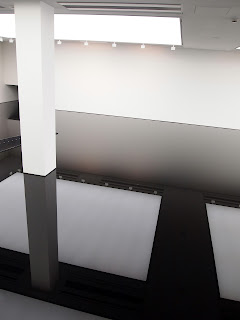

The smell is what I noticed first. The scent of oil reaches me as I walk on to the viewing balcony of this vast exhibit. The funny thing is that I don't see the oil that my nose detects. I look down, peering over the viewing balcony.There's a floor several metres down from me. I see that it's completely symmetrical and identical to the roof above, the pillars are exactly the same length, each shadow mirrors the other. Everything is the same. Judging by the symmetry of everything, I realise that the floor can't be real. 'It must be a mirror' I think, but why is the reflection so much darker than the real ceiling? Is the mirror waxed? Is it painted? To clear the matter I consult the exhibit's description. It turns out that this parallel world is merely a reflection made by a tank brimming with sump oil.
This is 20:50 by Richard Wilson. This exhibit is the only one in the Saatchi Gallery that is permanent. It's left people baffled, making it one of the world's largest puzzles. After taking minutes trying to work out what the exhibit was, I then examined it. Looking down I could see little puddles where the more inquisitive visitors had tried to spit in it to see if it's liquid. I could see the occasional ball of chewing gum which had been dropped by the daring. Some would call that vandalism, I think it's art. Those pieces of gum and puddles of spit had contributed to the entire piece. I wonder if Wilson expected people to do that, if he wanted them to vandalise his art by dropping their pennies in to it. The huge, dark mass of sump oil has drawn in these people, driven them to such curiosity that they can't resist the temptation to subtly spit at it. The artist has succeeded in luring people in, making them think for minute after minute. He's created a trap; a trap for humans.
A mini-pier stretches out in to the black void, so the vulnerable humans can walk straight in to the trap. It gives you a whole new understanding of the word space. When you realise that it's sump oil, you see that you're actually in quite an intimate room. The ceiling is only three metres above you, and the other side of the room is only seven or eight metres away from you. The presumption that this is an immense, spacious room is a wrong one. Again, Wilson has succeeded. He is trying to make you notice things for what they are, even when they're staring at you in the face. He's asking you to pause and to ponder about what you're seeing. And I wonder if unlike most artists, he's completely fine with you tampering with his work, disturbing it with your chewing gum. He has me and everyone else on tip-toe, peering over a rail to stare at a pool of cheap sump oil. This is modern art at it's best.


